Life in Tripontium
Introduction
Tripontium (Latin for the place of the three bridges) was a small Roman town near the modern town of Rugby which developed from the early first century AD until its decline in the fourth century.
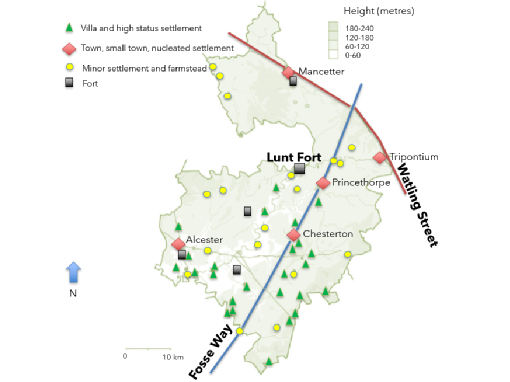
The First Inhabitants
As can be seen from the maps below, the area of Warwickshire/the Midlands was home to the Corieltauvi, Catuvellauni and Dobunni tribes. You can read more about these tribes and their locations here.
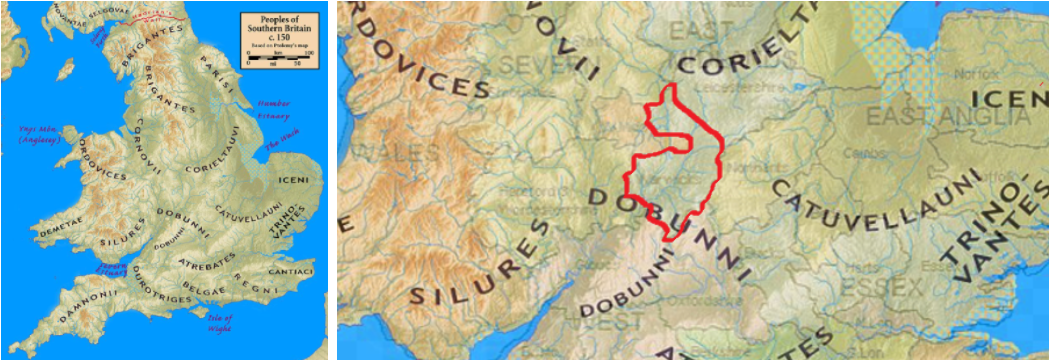
Towards Tripontium, the tribal boundaries of the Corieltavi and Catuvellauni can be seen to lie close together (the Dobunni seem to have been found towards the west of modern-day Warwickshire). Tribes might best be loosely understood as groups related in culture and language within a (sometimes very loose) territorial boundary.
How do we know where the different tribes occupied? Some but not all tribes had coinage before its wider introduction by the Romans and so evidence of their concentration can help to mark boundaries. But there will always be some elements of guesswork when reconstructing boundaries.
Which tribe occupied Rugby? The Corieltauvi – the name of the tribe was inscribed on a fragment of tegula (roof tile)
The Corieltauvi Tile:
The tribe was once known as the Coritani due to corruptions in the ancient text of the 'Antonine Itinerary' which records the main posting stations along the major roads of the Roman Empire. The inscription on this tile confirms that the name of the tribe was in fact the Corieltauvi and so is an extremely important object in changing traditional scholarship and local history.
The Coming of the Romans
Below is a map of Watling Street marked with the names of neighbouring posting stations. Watling Street was the main arterial route which connected the Midlands to London and Wales. The road was also important for administration, transport, and trade.
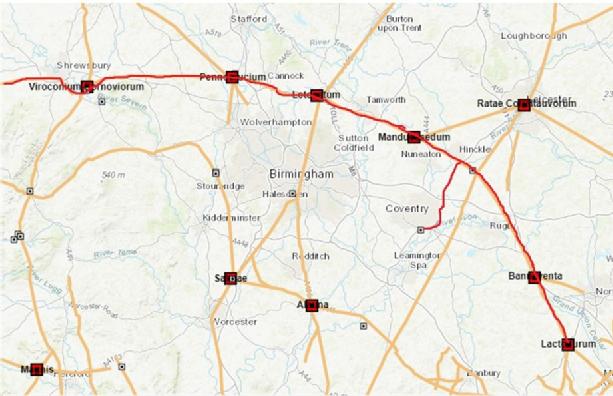
The road was lined with Claudian (i.e. built at the time of the Claudian invasion after AD43) marching camps which were used during the initial conquest and later Flavian forts (i.e. of around the time of the Flavian dynasty of Roman emperors beginning with Vespasian in AD69 and ending in AD96), an example of which has been reconstructed at Lunt, Coventry which may have been built in the AD60s.
Watling Street was metalled (i.e. its surface was levelled and paved with small stones) at around the same time as the construction of the permanent forts and surrounding settlements known as vici. These settlements are known as small towns due to their smaller size than larger towns and cities. Such towns are characterised by ribbon settlement development (settlements developing in accordance with main roads), minimalist houses, and few public buildings. Vici are often of military development and supported veterans and their families.
The Mansio
The image of the reconstruction of a mansio at Chelmsford (below), gives an impression of what the final phase at Tripontium may have looked like.
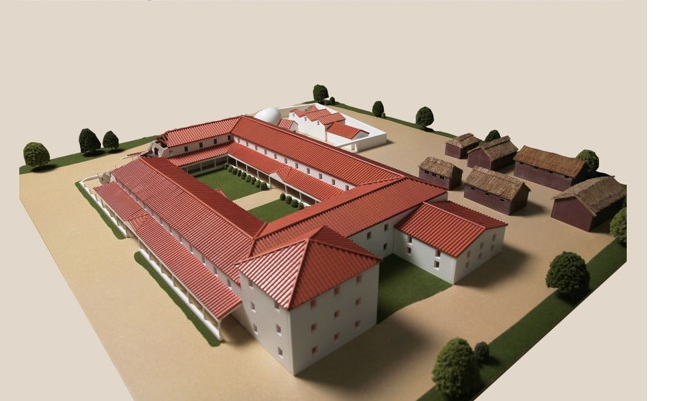
Mansiones – administrative buildings which provided accommodation for travellers and Roman officials using the cursus publicus (administrative system which required animals, food, and accommodation as provisions).
Different functions of mansiones – also for exchange of horses known as mutationes, positioned at sites on map roughly 10-20 miles apart which was the estimated distance that horses could cover in a day and could be exchanged for well-rested horses to carry on their journey – horseshoes have been found in the area around the mansio at Tripontium attesting to such functions.
Animal fodder and wells would also make sure that there was plenty of food and fresh water for the travellers and their horses.
1 timber phase in Flavian period and rebuilt twice in stone from second century with continuous alterations. Latest phase took on traditional courtyard style arrangement – dining areas, bathing suite, meeting halls, offices, kitchen, service areas, and sleeping areas.
Key points about the mansio:
- Accommodation for Roman officials and travellers.
- A place that provided food and water for visitors.
- Some had associated stables to exchange horses.
- Held administrative functions (paying taxes).
The Bathhouse
The bathhouse (below) immediately to the south of the mansio would have served guests and local residents until the addition of a private suite in the mansio if officials did not want to bathe in public.
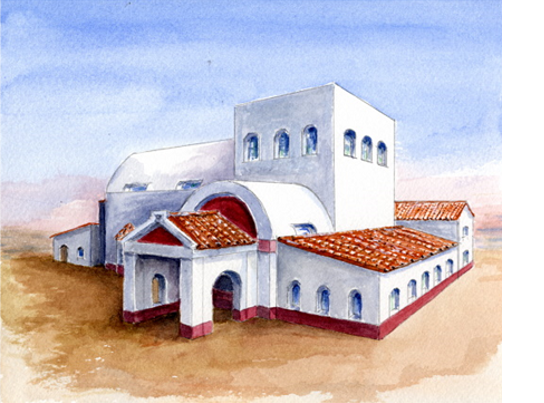
Two major building phases with a twenty year interval between them due to abandonment, possibly because of trouble on Hadrian’s Wall. First phase (Flavian) consisted of a traditional ‘row type’ containing the frigidarium (cold room), tepidarium (warm room), and caldarium (hot room). These were the standardised rooms which could be classified as baths when associated with each other and are the most common type of complex found in provinces. These rooms still allowed the visitor to participate in a traditional bathing regime in which the warm room was used to acclimatise the bather to the environment before attending the hot room and eventually cooling down in the cold room.
Second phase (Hadrianic) much larger and grander with additions of the atrium (reception area which also contained niches for statues), apodyterium (changing area), and palaestra (exercise hall).
Bathing in the Roman world was not only important for hygiene but was also a social activity. Bathhouses allowed visitors to socialise, play games, and eat and drink together. At Tripontium, game counters were found suggesting that such games and gambling did take place here.

Oyster shells were also found in the cold room which are evident of food consumption.

Intaglios (gem inset rings) were found in the main drain one of which bore a depiction of Jupiter-Serapis with a corn measure on his head. Only three intaglios of this kind have been found in Britain and were likely to have been possessed by an eastern trader due to the depiction of a Mediterranean deity with corn. The baths attracted food and wine sellers as they were busy places and ensured business.
Key points about the bathhouse:
- Not just used for washing but also for socialising.
- Evidence of food and drink being consumed within the baths.
- A centre for traders to sell items to visitors.
- Continued in use until the fourth century AD.
The Town
The central core of the town consisted of the mansio and bathhouse, but settlement was not restricted to these areas. Roads and trackways branched off of Watling Street and settlements developed around them mostly in the form of strip-buildings. Strip-buildings were rectangular structures which had an open end facing the road and a private space at the back. The open ends would have acted as shops, stools, and industrial areas to allow business from passers-by on Watling Street and to allow for smoke to escape if they were involved in crafting. The private spaces at the back were domestic rooms.
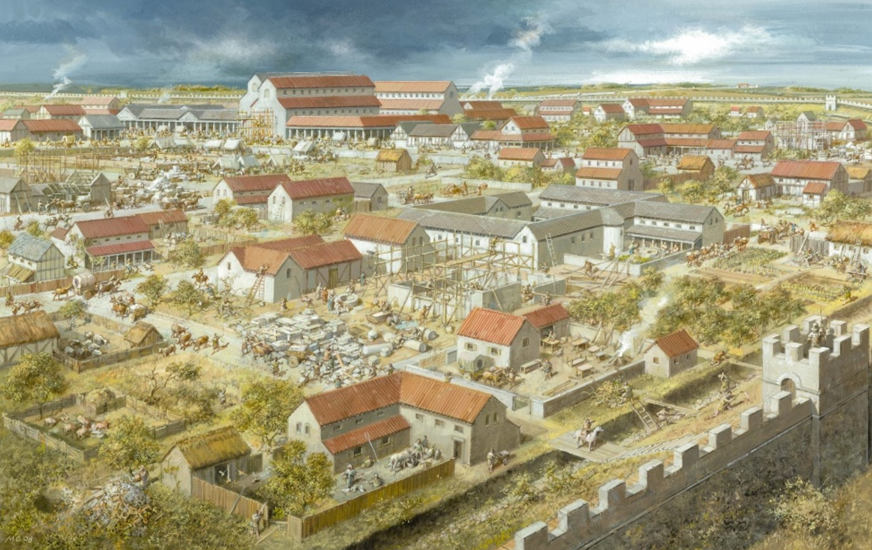
Mostly all of these houses had private land to keep pigs, sheep, horses, and cows which could be used for labour to plough the fields, to produce milk and wool, and to provide food. Many estates and larger plots associated with villas were involved in large scale production that was too much for local consumption. This surplus would have been sold at markets within the town and transported further away to supply the Roman army as they advanced north.
Cemeteries around the town reveal that large families lived in the town which is also evidenced by a bowl scratched with the name of a child, DECVMA, the tenth child.

It is likely that the inhabitants were partly literate as another roof tile was found in the area of the public buildings inscribed with the most complete form of the Latin alphabet known in Britain.
The End of Tripontium
All towns in Britain declined in the fourth century AD and Tripontium was one of them. Decline is evidenced by the abandonment of public buildings and domestic structures that were previously repaired. The mansio was left in a state of disrepair and rooms of the bathhouse were converted into use as normal rooms of unknown function.
Widespread abandonment in Britain was most likely due to the threat of barbarian raids. Towns responded to such attacks by the construction of defences which protected the main buildings.
There is very little evidence to interpret this stage of the town’s life although Tripontium did continue to be occupied into the Saxon period.
A belt buckle was found in the later defences which depicted a peacock either side of a fruit tree. This is evidence for the spread of Christianity in the area as this imagery was popular in Christian funerary art and symbolised the afterlife and resurrection of the soul.
